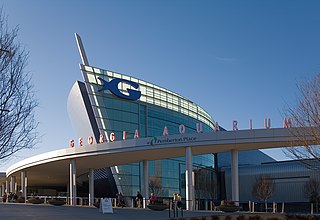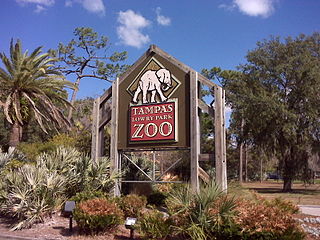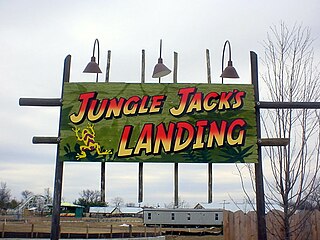
The cownose ray is a species of Batoidea found throughout a large part of the western Atlantic and Caribbean, from New England to southern Brazil. These rays also belong to the order Myliobatiformes, a group that is shared by bat rays, manta rays, and eagle rays.

The Fort Wayne Children's Zoo is a zoo in Fort Wayne, Indiana, United States. Since opening in 1965, the 1,000-animal zoo has been located on 40 acres (16 ha) in Fort Wayne's Franke Park. The Fort Wayne Children’s Zoo is operated by the non-profit Fort Wayne Zoological Society under a cooperative agreement with the Fort Wayne Parks and Recreation Department. The zoo receives no tax funding for operations and operates solely on earned revenue and donations.

Shedd Aquarium is an indoor public aquarium in Chicago. Opened on May 30, 1930, the 5 million US gal aquarium holds about 32,000 animals and is the third largest aquarium in the Western Hemisphere, after the Georgia Aquarium and Monterey Bay Aquarium.

The Columbus Zoo and Aquarium is a non-profit zoo located near Powell in Liberty Township, Delaware County, Ohio, United States, north of the city of Columbus. The land lies along the eastern banks of the O'Shaughnessy Reservoir on the Scioto River, at the intersection of Riverside Drive and Powell Road. It has a worldwide reputation, largely attributable to the efforts and promotion of director emeritus Jack Hanna. In 2009, it was named by the USA Travel Guide as the number one zoo in the United States. It was also ranked number one best zoo in 2012 by Besties Readers Choice.

Jack Bushnell Hanna is a retired American zookeeper and a former director emeritus of the Columbus Zoo and Aquarium. "Jungle Jack" was director of the zoo from 1978 to 1992, and is viewed as largely responsible for elevating its quality and reputation. His media appearances, particularly with David Letterman, James Corden, Good Morning America, and Maury Povich have made him one of the most notable animal experts in the United States. A 2021 documentary, The Conservation Game, alleged that Hanna participated in the mistreatment and private trade of exotic and endangered animals.

Georgia Aquarium is a public aquarium in Atlanta, Georgia, United States. It exhibits hundreds of species and thousands of animals across its seven major galleries, all of which reside in more than 11 million US gallons (42,000 m3) of water. It was the largest aquarium in the world from its opening in 2005 until 2012 when it was surpassed by the S.E.A. Aquarium in Singapore and the Chimelong Ocean Kingdom in China; the Georgia Aquarium remains the largest aquarium in the United States and the fifth largest in the world.

The Waikīkī Aquarium is an aquarium in Honolulu, Hawaii, United States. It was founded in 1904 and has been an institution of the University of Hawaiʻi at Mānoa since 1919. The aquarium is the second-oldest still-operating public aquarium in the United States, after the New York Aquarium.

The Cleveland Metroparks Zoo is a 183-acre (74 ha) zoo in Cleveland, Ohio. The Zoo is divided into several areas: Australian Adventure; African Savanna; Northern Wilderness Trek, The Primate, Cat & Aquatics Building, Waterfowl Lake, The RainForest, and the newly added Asian Highlands. Cleveland Metroparks Zoo has one of the largest collections of primates in North America, The Zoo is a part of the Cleveland Metroparks system.

ZooTampa at Lowry Park is a 63-acre (25 ha) nonprofit zoo located in Tampa, Florida. In 2009, Lowry Park Zoo was voted the #1 Family Friendly Zoo in the US by Parents Magazine, and is recognized by the State of Florida as the center for Florida wildlife conservation and biodiversity. The zoo is operated by the Lowry Park Zoological Society, an independent 501(c)(3) charitable organization. The zoo also exists as a center for conservation of endangered wildlife both locally and around the globe. Tampa’s Lowry Park Zoo is accredited by the Association of Zoos and Aquariums (AZA) as well as a member of the World Association of Zoos and Aquariums (WAZA), Conservation Breeding Specialist Group (CBSG), the Florida Association of Zoos and Aquariums (FAZA) and the Florida Attractions Association (FAA).

Point Defiance Zoo & Aquarium (PDZA) is the only combined zoo and aquarium in the Pacific Northwest, located in Tacoma, Washington, US, owned by Metro Parks Tacoma. Situated on 29 acres (12 ha) in Tacoma's Point Defiance Park, the zoo and aquarium are home to over 9,000 specimens representing 367 animal species. The zoo was founded in 1905; the aquarium was founded in 1935 near Commencement Bay and relocated within the zoo in 1963. Both are accredited by the Association of Zoos and Aquariums. In Pierce County, Washington, this is said to be one of the most popular tourist destinations. Bringing in over more than 600,000 visitors per year.

The New England Aquarium is a nonprofit organization located in Boston, Massachusetts. The species exhibited include harbor and northern fur seals, California sea lions, African and southern rockhopper penguins, giant Pacific octopuses, weedy seadragons, and thousands of saltwater and freshwater fishes. In addition to the main aquarium building, attractions at Central Wharf include the Simons Theatre and the New England Aquarium Whale Watch. More than 1.3 million guests visited the aquarium each year prior to the outbreak of the COVID-19 pandemic.

Zoombezi Bay is a 22.7-acre (9.2 ha) water park owned by the Columbus Zoo and Aquarium near Powell, Ohio just north of Columbus. The park sits on the site of the former Wyandot Lake Adventure Park, which was purchased by the Columbus Zoo and Aquarium in 2006. Zoombezi Bay opened to the public on May 26, 2008, and currently ranks as one of the Midwest's most popular water parks, attracting more than 400,000 visitors annually.

Mote Marine Laboratory is an independent, nonprofit, marine research organization based on City Island in Sarasota, Florida, with additional campuses in eastern Sarasota County, Boca Grande, Florida, and the Florida Keys. Founded in 1955 by Eugenie Clark in Placida, Florida, it was known as the Cape Haze Marine Laboratory until 1967. The laboratory aims to advance marine science and education, supporting conservation and sustainable use of marine resources. A public aquarium and associated education program interpret its research for the public.

The Florida Aquarium is a 501(c)(3) non-profit organization, publicly operated institution located in downtown Tampa, Florida, United States. It is a large scale, 250,000-square-foot (23,000 m2) aquarium and is accredited by the Association of Zoos and Aquariums. This means they are a leader in conservation and education, supporting programs for wildlife and having a strong educational component in the forms of summer camps, school trips, etc. The facility is home to more than 7,000 aquatic plants and animals from Florida and all over the world. The facility is located in the Channel District of Downtown Tampa. The Florida Aquarium opened in March 1995 as a privately funded entity and became a public-private partnership when the city of Tampa assumed responsibility for its debt in 1999. On April 18, 2012, the AIA's Florida Chapter placed the Florida Aquarium on its list of Florida Architecture: 100 Years. 100 Places.

The Texas State Aquarium is a nonprofit aquarium located in Corpus Christi, Texas, United States. It aims to promote environmental conservation and rehabilitation of the wildlife of the Gulf of Mexico. It has been accredited by the Association of Zoos and Aquariums (AZA) since 1995. It is the largest aquarium in Texas, and one of the largest aquaria in the United States.

A public aquarium or public water zoo is the aquatic counterpart of a zoo, which houses living aquatic animal and plant specimens for public viewing. Most public aquariums feature tanks larger than those kept by home aquarists, as well as smaller tanks.

Rides At Adventure Cove is a small amusement park area that is part of and owned by the Columbus Zoo and Aquarium in Powell, Ohio. The park was originally part of Wyandot Lake before the zoo purchased the property in 2006, splitting it into two separate sections after the 2006 season. The water park became known as Zoombezi Bay while the dry ride area became Jungle Jack's Landing. The amusement park was named after zoo director emeritus Jack Hanna and opened on May 26, 2008. It debuted with 14 rides and attractions, several of which were retained from the former Wyandot Lake. In 2020, the Jungle Jack's Landing name was dropped with the amusement park area being renamed to tie into the neighboring Adventure Cove area of the Columbus Zoo and Aquarium which opened for the first time on the same year.
Heather Pick was an American television news anchor as well as an activist on behalf of breast cancer awareness and juvenile diabetes. She began her career in newscasting at WREX-TV in Rockford, Illinois before moving in 2002 to Columbus, Ohio where she was the morning and noon news anchor for WBNS-TV.
SECORE is an international non-profit organization focused on coral reef conservation. The group has over sixty supporters in North America, Europe and Japan, and comprises public aquariums, institutes, and universities. Founded in 2001 at the Rotterdam Zoo in the Netherlands, the organization has been developing methods of captive coral reproduction and preservation, citing studies that have predicted coral reefs could be extinct within decades due to climate change.

The Greater Cleveland Aquarium is an aquarium in Cleveland, Ohio. Occupying the historic FirstEnergy Powerhouse building located on the west bank of the Cuyahoga River in the city's Flats district, the aquarium, which opened in January 2012, consists of approximately 70,000 square feet (6,500 m2) of exhibition space and features 55 exhibits over 9 thematic concentrations representing both local and exotic species of fish. The facility is the only independent, free-standing aquarium in the state of Ohio and ended a 26-year period that the city lacked a public aquarium.




















